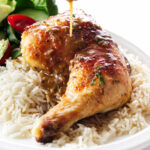Honey Mustard Baked Chicken Quarters
These baked chicken quarters get slathered in a sweet and savory honey mustard glaze that turns into a delicious spooning sauce. Drizzle the sauce over the chicken or a side of rice or potatoes. Check the notes for recipe variations to change the flavor up and serve this easy and economical chicken dinner several nights per month.
Servings: 4 servings
Ingredients
For the Honey Mustard Sauce
- 4 tablespoons honey
- 2 tablespoons Dijon mustard
- 1 tablespoon olive oil
- 3 to 4 garlic cloves grated or finely minced
- 1 tablespoon chopped fresh rosemary
- 1 tablespoon apple cider vinegar
- 2 teaspoons Worcestershire sauce
- ½ teaspoon salt
- ¼ teaspoon ground black pepper
- ⅓ cup chicken broth or white wine
For the Chicken Quarters
- 4 chicken leg quarters leg and thigh
- ½ teaspoon smoked paprika
Instructions
- Preheat the oven to 425°F and spray a 13 x 18-inch baking sheet with non-stick cooking spray.
- In a small dish, whisk together the honey, Dijon mustard, olive oil, garlic, rosemary, vinegar, Worcestershire, salt, and pepper. Set the dish aside while you prep the chicken quarters.
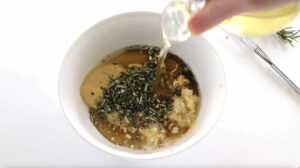
- Pat the chicken quarters dry with a paper towel. Trim away the excess fat and remove any pin feathers if present. Place the chicken on the baking sheet.

- Brush half of the honey-mustard mix on the underside of the chicken quarters. Flip them over and brush the remaining mix on the skin side, lifting the skin as much as possible to get the sauce underneath the skin. Dust lightly with paprika.
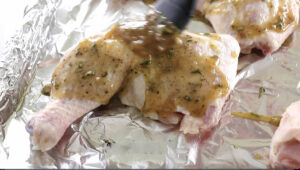
- Pour the chicken broth (or white wine) directly into the sheet pan, without pouring it on top of the chicken.
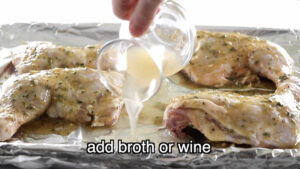
- Transfer the baking sheet to the oven and bake for 45 minutes. When the chicken has roasted for 20 minutes, rotate the pan and tent with foil to prevent over-browning. Remove the tent for the last 5 minutes to crisp the chicken skin.
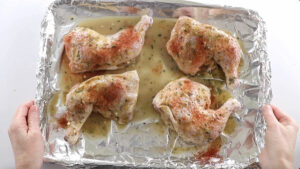
- Cook chicken quarters until the internal temperature reaches 175°F. While chicken is safe to eat at 165°F, dark meat has more connective tissue and needs the extra time to turn juicy and tender. If they haven’t reached 175°F after 45 minutes, keep baking and check the temperature every 5 minutes.
- Remove from the oven and allow to rest 5-10 minutes before serving.
Video
Notes
Use a large pan: A half sheet pan (13 x 18 inches) gives the chicken plenty of space. If the pan is too small, the chicken will sit in liquid and boil instead of roast.
Aim for 175°F: While chicken is safe at 165°F, quarters taste best at 175°F when the connective tissue in the dark meat has broken down.
Check with a thermometer: An instant-read thermometer gives the most reliable results. If you don’t have one, cook until the juices run clear, but a thermometer is more consistent.
Nutrition
Serving: 1 serving | Calories: 194kcal | Carbohydrates: 13g | Protein: 14g | Fat: 10g | Saturated Fat: 2g | Polyunsaturated Fat: 7g | Cholesterol: 53mg | Sodium: 353mg | Sugar: 12g
